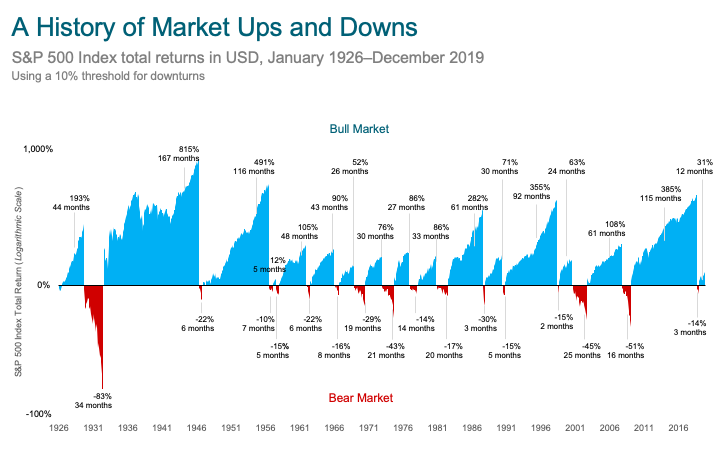Weight Watchers, the iconic American health and wellness giant, filed for…

Should I Be Buying or Selling Stocks Now
It seems investor sentiment has quickly changed since the beginning of the year, not to mention from just about 10 days ago as witnessed by the recent stock market decline. Many argue “why” this has happened and here’s a quick look at the potential reasons:
Coronavirus: Most argue this is the primary reason for the recent market sell-off. It’s certainly terrible what is happening across the globe to humans who are suffering or have passed away. Our hope is that we have containment and a cure soon.
Presidential Election Uncertainty: Others will point to the future expectation being priced in on who will win the next election based on recent debates. We won’t go here, especially because the market will figure it out faster and price it in before any of us can profit from the future results.
“We were due for a correction”: Always a classic reason for market sell offs, especially coming off all-time market highs just a couple of weeks ago.
Insert your own “crisis of the day”: We are adding this one in advance of what will happen in 2020 and beyond. We don’t know what the next crisis will be or when, but its highly probable that it will be something we can’t control or predict.
Who should be concerned? Its simple: those who have not put a good financial plan in place. For those of you who have taken the time to establish a well-thought-out financial plan, you’ve been planning for short-term market fluctuations like this which will have no impact on your current or future lifestyle. For the latter audience, it is also probable that you and/or your advisor are rebalancing your portfolio given the opportunity. This is how risk is properly managed and how investors build a larger nest egg over time. It is also what we call investor discipline, but we know its not always easy to watch depending on your stage of life.

Chart end date is 12/31/2019, the last trough to peak return of 451% represents the return through December 2019. Bear markets are defined as downturns of 20% or greater from new index highs. Bull markets are subsequent rises following the bear market trough through the next new market high. The chart shows bear markets and bull markets, the number of months they lasted, and the associated cumulative performance for each market period. Results for different time periods could differ from the results shown. Past performance is no guarantee of future results. Indices are not available for direct investment; therefore, their performance does not reflect the expenses associated with the management of an actual portfolio. Source: S&P data © 2020 S&P Dow Jones Indices LLC, a division of S&P Global. All rights reserved.
In light of recent investor questions, market volatility, lower interest rates, and lower inflation expectations, we thought we would leave you with some additional food for thought as you might be considering rebalancing and/or different investment strategies going forward. And of course, beware of those trying to sell you the “guaranteed” products that are not a fit. These folks seem to be everywhere at a time like this.
Investment Strategy Considerations/Risks:
PASSIVE FIXED INCOME
Many investors use the Barclays Agg as a proxy for the fixed income universe. The Barclays Agg has no TIPs, 28% of the index is short volatility and 32% has credit spread risk. Some larger, well-known mutual funds hold this type of risk.
REAL ESTATE
While rates are extremely low, any jump in higher rates increases the all-in cost of buying a home or other property, which can depress demand. Increased rate volatility can reduce mortgage lenders’ appetite for new loans.
MINIMUM VOLATILITY / LOW VOLATILITY STOCKS
Min vol / low vol stocks can be seen as “defensive” and used with the goal to generate yield with less equity risk than the broader market. However, investors might be overpaying for “safe” stocks. These stocks have nothing to do with owning “volatility”.
SHORT DURATION BONDS / TIPS
TIPS are set using the Consumer Price Index (CPI), which only represents today’s inflation level.
FLOATING RATE NOTES (FRN)
Frequently used to profit from higher yields, FRNs may have credit risk and almost no sensitivity to interest rates. Currently, 91% of the bonds trading in the Bloomberg Barclays Floating Rate <5 Year Index are trading above par.
PRIVATE ALTERNATIVE INVESTMENTS
While some private acts may serve as a good diversifier, caution is recommended as most strategies in this arena perform just like the stock market with a lag in reporting. Not to mention, most are super expensive, over-leveraged, and illiquid.
EQUITIES / GLOBAL STOCKS
Global Equities are a very efficient and low-cost way to gain exposure to the capital markets. They can also serve as a way to keep pace with inflation over time. Given their risk/return characteristics, global equities are subject to market sell-offs due to deteriorating economic conditions.
Of course, there is a lot more to consider given investor needs, circumstances, and risk tolerance. Having a well-designed plan can address most of these concerns and uncertainties.
As always, we are here to help.
Cheers,
CAM Investor Solutions
Source: S&P data © 2020 S&P Dow Jones Indices LLC, a division of S&P Global. All rights reserved; Bloomberg; Dimensional Fund Advisors; Nancy Davis, Quadratic Capital Management, LLC; M & A Consulting Group, LLC, doing business as CAM Investor Solutions is an SEC-registered investment adviser. As a fee-only firm, we do not receive commissions nor sell any insurance products. We provide financial planning and investment information that we believe to be useful and accurate. However, there cannot be any guarantees. This blog has been provided solely for informational purposes and does not represent investment advice or provide an opinion regarding the fairness of any transaction. It does not constitute an offer, solicitation or a recommendation to buy or sell any particular security or instrument or to adopt any investment strategy. Any stated performance does not reflect the expenses associated with the management of an actual portfolio. Past performance is not a guarantee of future results. Diversification does not eliminate the risk of market loss. Charts and graphs provided herein are for illustrative purposes only. There are many different interpretations of investment statistics and many different ideas about how to best use them. Nothing in this presentation should be interpreted to state or imply that past results are an indication of future performance. Tax planning and investment illustrations are provided for educational purposes and should not be considered tax advice or recommendations. Investors should seek additional advice from their financial advisor or tax professional.



